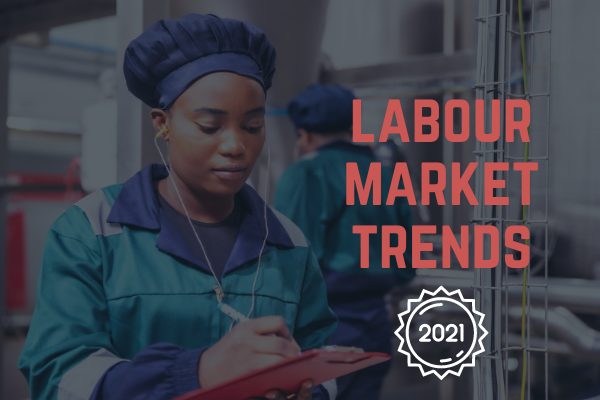Trend #1: Continuous bargaining for trade unions
South Africa entered the covid-19 pandemic with a weak economy which deteriorated over 2020. Renewed lockdown measures in 2021, load shedding and access to covid-19 vaccines are some of the issues that could erode the gains reported towards the end of last year. Despite the reopening of many sectors of the economy, the unemployment rate continues to worsen with 7.2 million people affected, according to the latest Quarterly Labour Force Survey. Companies took various cost-saving measures, including laying-off and retrenching workers.
The pandemic brought to the forefront key trade union issues like job security, occupational health and safety, non-discrimination and inclusivity. Bargaining has become almost continuous, rather than being confined to traditional cycles of negotiation. The collective agreement became an even more important tool for unions to use in protecting workers, saving jobs and demanding more benefits and a say in the crisis response plans of employers.
What does it mean for unions?
“Trade unions are facing two kinds of employers: genuinely distressed companies and companies who can afford wage increases but will use the pandemic as the excuse to refuse any demand for increases. With the current context and an inflation rate of 3.2%, it will not be easy to bag wage awards of more than 6%. The hard decision facing trade unions is whether to save jobs or to negotiate for higher wages and risk job losses in probably six months.”
George Mthethwa, Educator and Facilitator, Collective Bargaining Support programme.
Trend #2: Lay-offs and retrenchments place a further strain on trade union representivity in some workplaces
What does it mean for unions?
- Retrenchments should be the last resort and unions need to have it in the priority demands.
- Strengthen bargaining with evidence, through analysing the available financials of a company. Identify revenue, profit, remuneration of senior executives and information related to the workers to ensure it corroborates with what the union knows. Think of some alternatives to retrenchment, specifically the potential of reskilling and moving people to the different parts of the business.
“The economy is under strain and our research shows some sectors have been harmed more than others. Many companies can’t necessarily corroborate their claims about the extent of the impact of the covid-19 pandemic. We’ve interrogated some of the claims made by big retail companies with regards to profits and found that executive pay over the last year hasn’t taken much hit. Unions need to ask why so many workers are getting retrenched while executives continue to receive such high bonuses.”
Dr Salomé Teuteberg, Project Leader, Transforming Corporate Governance Programme.
Trend #3: Shift to remote working will intensify
There has been a significant increase in remote working and an increase in the way that employers monitor workers, especially with regards to tracking productivity. Some workers are expected to virtually clock in and out, while other employers have increased data collection on worker productivity. Additionally, some benefits achieved through union bargaining, such as transport and food allowances, have been eroded with the uptake of remote working.
What does it mean for trade unions?
Remote working has brought new bargaining issues such as time management and communication costs, and a need for increased monitoring to ensure enforcement of existing agreements. Remote working may also mark the beginning of the externalisation of a new range of jobs by companies. Trade unions must be alert to employer efforts to push these issues through collective bargaining.
Trend #4: Women have been disproportionately affected by covid
The health crisis has brought to light gaps in the labour market and highlighted the most vulnerable workers. Women, low-paid workers, self-employed and temporary workers have been hit the hardest.
“The covid-19 pandemic put inequality back on the spotlight after a period of lacklustre discourse. There’s now an opening to develop strategies for responding decisively. Women will seek ways to increase their agency and campaign for some of the issues causing a further slide in the levels of inequality.”
Nina Benjamin, Project Leader, Gender Equality Programme. Tweet
What does it mean for trade unions?
- Develop and intensify women’s leadership programmes
- Review State and union policies on women economic empowerment and suggest ways of improving to suit the current context
- Identify and prioritise the demands relating to care workers
- Increase focus on real inclusion in workplaces
- Ensure women’s access to technology
- Ensure the participation of women in discussions on emerging workplace issues
- Push for the expansion of the Expanded Public Works Programme as a response measure to inequality.
Trend #5: The value of work
The idea of essential services has been redefined to include not just health practitioners, but also workers in the production of food and other necessities, frontline retail workers and workers in logistics and distribution. Essential services include information and communications technology.
What does it mean for trade unions?
This might present an opportunity to revalue work that has been devalued and workers that have been exploited in the past.
Trend #6: Precarious employment is rising rapidly
The uncertainty that the pandemic has caused in the economy has caused dramatic changing of traditional work models. Employers operating in a difficult economic climate look for innovative ways to reduce costs, and the pandemic has increased this trend. Previously permanent workers are now flexible, non-permanent, part-time or temporarily laid-off.
“The coronavirus crisis highlighted the issues affecting precarious workers and many of them qualify as key workers in the economy. There’s an opportunity to strengthen organising in vulnerable industries to ensure all workers benefit from the national minimum wage and have safety nets.”
Nosipho Twala, Educator and Facilitator, Gender Equality Programme.
Trend #7: The reorganisation of employment relationships
The pandemic made it clear that informal economic activity is vital to the livelihoods of many in South Africa. Trade unions need to accept and to work with the informal sector. Unions are already grappling with the informalisation of employment relationships and the fragmenting of their bargaining units. This is a starting point for developing a fresh understanding of how work is organised and what it means for employment.
Trend #8: Decreasing compliance with labour standards
The CCMA budget cut could affect the enforcement of the minimum wage because the consequences of not complying may not be as easy to enforce as they were before. Non-compliance with labour laws is historically widespread in South Africa. But this is not an argument for saying that measures like sectoral determinations and the national minimum wage don’t work. Health and safety in the workplace are non-negotiable and the pandemic provided further evidence that unions cannot rely on employers to implement what is required.
“Compliance has to be more multi-directional. Compliance follows the building of new shared social values or norms. Societal values become entrenched norms when all the different social actors collectively start to monitor and contribute to compliance, despite sometimes weak legal enforcement mechanisms. An entrenched social norm means that it is a shared value in a community or other grouping and non-compliance is viewed with animosity. Trade unions have an important role to play in promoting enforcement by highlighting non-compliance where they come across it.”
Trenton Elsely, Commissioner, National Minimum Wage Commission | Executive Director, Labour Research Service.







